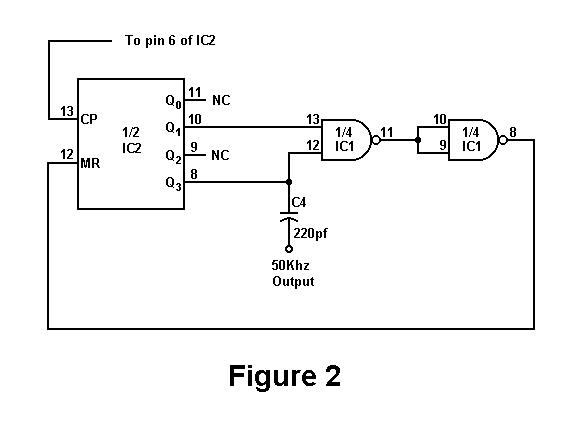高稳定100KHz时钟发生电路,100khz clock generator
关键字:高稳定100KHz时钟发生电路
Build A 100Khz Crystal Calibrator
By N1HFX
There is a great deal of old amateur gear which many amateurs have decided to restore and bring back to life. While much of the early amateur transceivers work just fine they usually lack a digital readout and must rely on analog dials for tuning. The problem of dial calibration is complicated by the non-linear effects of tuning capacitors. This month's circuit is a 100Khz crystal calibrator using an inexpensive microprocessor crystal and CMOS IC's which are readily available at Radio Shack.
The main problem with building a 100Khz oscillator is the unavailability of 100Khz crystals. Even if you find a vendor willing to cut such a crystal for you, plan on paying $20 or more not including shipping charges. The circuit in Figure 1 uses an inexpensive 8Mhz microprocessor crystal which can be easily obtained from most parts suppliers for about $1. Using a 74HCT393 binary counter IC, we can easily divide down the 8 MHz signal from our crystal into 100Khz or almost any frequency we need.
The circuit in Figure 1 uses a couple of NAND gates (74HCT00 IC) for our 8Mhz crystal oscillator. Capacitor C2 actually helps us tune the crystal to the exact frequency, Use any value of C2 from about 22pf to about 82pf to get the oscillator on frequency. In the prototype, 68pf worked fine for most of the crystals tested. For an exact frequency, replace C2 with a 22pf and add a 50pf trimmer capacitor in parallel. By adjusting the 50pf trimmer capacitor, we can easily get the crystal exactly on frequency. The first NAND gate is our oscillator while the second NAND gate acts as a buffer and conditions the signal. This signal is then fed into the clock pulse input of one of the 4 bit binary counters in IC2. By taking the output from the Q3 signal, we have now divided the signal by 16 giving us 500Khz. This signal is now fed into the clock pulse input of the second 4 bit binary counter. In the first counter we tied the MR (clock reset) line to ground. In the second counter, we need the count to reset when we reach a binary five, which will allow us to divide the 500Khz by 5. For this counter, we used the last 2 remaining NAND gates in IC1 to detect the desired value. When we reach the correct reset interval, the MR line goes high resetting the counter to zero and allowing us to effectively divide by 5. The 100Khz output is taken from the Q2 line and is coupled through capacitor C4.
If you prefer, this circuit can be easily changed to a 50Khz calibrator by wiring pins 13 & 14 of IC1 into pins 10 and 8 of IC2. See Figure 2 for details. This arrangement makes the second counter reset at binary 10 which divides the 500Khz by 10 giving us the desired 50Khz.
The HCT series CMOS logic IC's require a 5 volt power supply just like the old TTL logic series. In this circuit we used a 5 volt zener diode, D1, along with resistor R2 to get 12 volts down to 5 volts. Capacitor C3 is used primarily for bypassing the oscillator and must be used in this circuit. If you prefer to power this circuit from a 9 volt battery, then reduce resistor R2 to 220 ohms for best performance.
If you plan to install this circuit inside a transceiver, feed the output directly to the receiver front end. Make certain you have connected it after the TR relay so that the circuit doesn't get zapped by RF from the transmitter side. Also, you will want to install an ON/OFF switch which will interrupt the 12V line going to the circuit. As with all static sensitive CMOS IC's, use special handling precautions and do not leave out those IC sockets.
This circuit has been found to generate accurate birdies at every 100Khz and will be an excellent aid in getting that old rig right on frequency. The accuracy of the 100Khz birdies will depend on how close the 8Mhz oscillator is on frequency. With the difficulty in getting crystals for specific frequencies, this circuit gives new meaning to the words "Divide and Conquer".
要产生100千赫兹频率的电路,如果采用晶体管搭建的LC震荡电路,当要求频率很稳定时比较困难,而采用晶体震荡器则容易实现,而低频率的晶体震荡器又不容易获得,下面的电路就能够将频率较高的晶体震荡器通过适当的电路输出频率较低的信号。
电路原理简单,通过IC1的门电路,晶体以及外围电路组成8M赫兹震荡器,通过IC2分频获得100千赫兹信号。
DE N1HFX
下图是产生50千赫兹的电路,13脚接上图的IC2的6脚就可以了。
元件清单
Parts List
| C1
声明:本文内容及配图由入驻作者撰写或者入驻合作网站授权转载。文章观点仅代表作者本人,不代表电子发烧友网立场。文章及其配图仅供工程师学习之用,如有内容侵权或者其他违规问题,请联系本站处理。
举报投诉
发布评论请先 登录 相关推荐 AD7841需要设置为以100KHZ或者1KHZ采样率对连续128点采样时,应该怎么设置采样率?
您好,我现在在用ADS7841,芯片资料上说它最高可以达到200KHZ的转换率,我想问下 当我需要设置为以100KHZ或者1KHZ采样率对连续128点(或更过点的采样时)采样时,应该怎么设置采样率
发表于 02-07 06:39
ads8681标称1mHz的采样率,如果要采样100khz的信号,是否可以正确采样,能否旁路低通滤波器?
请问,ads8681标称1mHz的采样率,但是有个低通滤波器,似乎只能猜到15khz以下的信号,请问如果要采样100khz的信号,是否可以正确采样,能否旁路低通滤波器,谢谢
发表于 12-30 06:47
请问DS90UB903Q的IIC工作频率必须为100KHz吗?
问题:DS90UB903Q的IIC工作频率必须为100KHz吗?
问题发生条件:芯片配置:DS90UB903Q的工作电压为1.8V,VCCIO为3.3V;MODE=1,PDB=1;Rid=0ohm
发表于 12-26 07:08
想要测量100KHZ的正弦波的幅值,用ADS1258可以吗?
我想要测量100KHZ的正弦波的幅值,用ADS1258可以吗?是需要先转换成直流然后进行测试吗? 有没有相关的案例,谢谢
发表于 12-13 06:01
AFE5818EVM采集100KHz左右方波信号,采集数据不准确的原因?怎么解决?
问题:1)输入100KHz方波信号,脉冲组(含50个方波),Vpp=100mV,占空比可调,不同占空比时,使用TSW1400采集信号的电压幅值不同,不知道原因?
2)同时方波信号还伴有爬坡过程
发表于 11-25 07:32
求助,有适合100kHz~500kHz的集成放大器芯片吗?
如题,Ti 有适合100kHz~500kHz 的集成放大器芯片吗?功率不超过50w,单电源供电的。
目前看到的绝大部分是音频功放。
发表于 10-16 07:34
INA128对100kHz 2mV的100倍放大,怎么达不到?
在输入信号为100kHz 2mV时,选用的电阻为505.1Ω,设计增益为100,但仿真出来的结果是181mV,增益为90.5。可是INA128的增益带宽积在G=100时,可达到200kHz
发表于 09-20 08:28
OPA564-Q1从20kHz~100kHz这个频段的THD+N指标是多少呢?OPA564-Q1的信号频率范围是1k~100kHz,输入电压峰值10v(即峰峰值+-10v,其中DAC为20位,最大支持+-15v的电压峰峰值输出);OPA564-Q1的输出负载为感性负载(直流电阻4欧,电感
发表于 09-13 07:45
TLV3501输入的正弦超过100KHz输出的方波就会出现失真,怎么解决?按照技术手册做的一个过零比较器,但是输入的正弦(峰峰值2V)超过100KHz输出的方波就会出现失真?怎么办。
发表于 08-26 07:29
OPA365芯片明明增益带宽50MHz,为什么噪声密度曲线只到100KHz,后面频率就没了呢?
诸位大牛好!我想请教下,TI的OPA365芯片明明增益带宽50MHz,但为什么噪声密度曲线只到100KHz,后面频率就没了呢?
如果想知道其工作在500KHz的噪声密度怎么办?谢谢诸位解答!!!祝心情愉快~
发表于 08-21 07:33
OPA2333积分电路100k频率不放大是怎么回事?
图一20mv 50hz正常放大;图二20mv 100khz放大信号过小。有什么办法可以100khz放大20mv到1V
发表于 08-05 08:00
LF353运放输入20khz的正弦波,低通滤波截止频率100khz后有相位差如何解决?
运放输入20khz的正弦波,低通滤波截止频率100khz后有相位差,有啥办法解决吗
发表于 07-31 06:00
使用CX3为EVAL_PASCO2_SENSOR添加寄存器,i2c运行频率如何设置为100kHz? 并为我的图像EVAL_PASCO2_SENSOR添加寄存器。 i2c默认运行频率为 400kHz,如何将其设置为 100kHz?
发表于 03-06 06:50
|




 高稳定100KHz时钟发生电路,100khz clock generator
高稳定100KHz时钟发生电路,100khz clock generator










评论